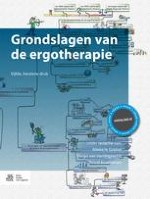Samenvatting
In dit hoofdstuk worden het PEOP-model en het bijbehorende PEOP OT-procesmodel beschreven. Het PEOP benadrukt de noodzaak van het competent zijn in het dagelijks handelen om participatie in het dagelijks en maatschappelijk leven mogelijk te maken, gericht op het ervaren van welzijn. In het PEOP-model zijn zowel de persoonlijke als de omgevingsfactoren belangrijk in het ergotherapeutisch proces van assessment en interventie. Beide worden in het PEOP-model gezien als ondersteunend of belemmerend in het mogelijk maken van het dagelijks handelen. Door het gebruik van het PEOP OT-procesmodel wordt duidelijk hoe de capaciteiten van de persoon en de facilitatoren van de omgeving het dagelijks handelen bevorderen en hoe de beperkingen van de persoon en de barrières van de omgeving het dagelijks handelen belemmeren. Het PEOP OT-procesmodel start met een narratief en maakt daarmee duidelijk dat betekenis in de ergotherapeutische interventie met de persoon en zijn systeem, organisatie of populatie het uitgangspunt is.
